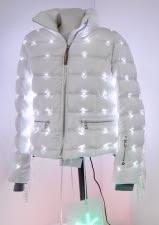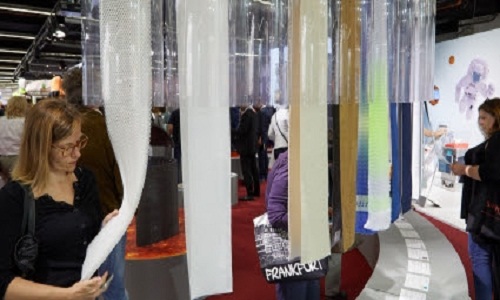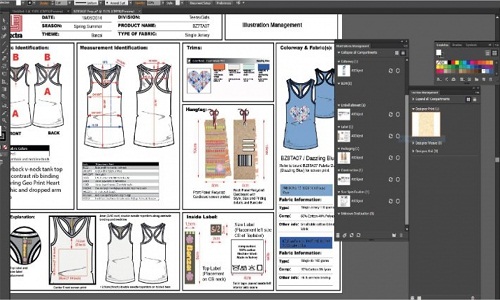FW
Archroma, a global leader in color and specialty chemicals, is keeping nature top-of-mind for its OutDoor 2017 ( an event organized by Messe Friedrichshafen, Germany) debut with a showcase of advanced innovations and solutions to enhance outdoor, urban and active wear. Under the motto: “Enhancing your gear, it’s our nature”, Archroma invites show visitors to discover how to Create exciting color effects, Make gear more resistant to extreme weather, to bring softness and comfort to your gear and lastly to take a sustainability step up. In keeping with the event’s progressive feel, easy-to-use Outdoor Solution Navigators will be available on touchscreens at the booth, side-by-side with experts and samples, to encourage visitors to explore their ideas and uncover new ways to enhance their gear sustainably. Visitors at the booth will also be able to discover the new fabric collection created by Flocus and colored with Archroma’s Earthcolors. Flocus is a company producing yarns, fillings and fabrics made from kapok fibers, for which they received the 2016 OutDoor Industry award in the Sustainable Innovation category.
There will be a 11 hours OutDoor conferences program with the presentation that will be held on 19th June that will present EarthColors technology – Garments from nature to the store”, Conference Center East, Room Paris. The presentation will be delivered by NuriaEstape, Head of Marketing & Promotion for Archroma’s Brand & Performance Textile Specialties business. Headquartered in Reinach,Archroma is a global color and specialty chemicals company. It operates in 35 countries and with 24 production sites. Archroma helps the outdoor, urban and active wear sectors bring ideas to life and develop collections with a soul. Its three businesses – Brand & Performance Textile Specialties, Packaging and Paper Specialties, and Coatings,deliver specialized performance and color solutions to meet customers’ needs.
With over 72 million followers, Nike has become the most popular fashion brand on Instagram. Swedish company H&M stands second in the list with over 21 million followers on Instagram.
Instagram is increasingly becoming an important marketing channel for retailers. The platform recently reached 700 million monthly active users, and its emphasis on visuals lends itself well to fashion brands. Instagram has been experimenting with shoppable posts recently, allowing brands to add product details and links to their photos.
This has made Nike the fifteenth most popular Instagram account in the world, beating celebrities like Khloe Kardashian and Miley Cyrus.
As the world’s most popular visual social network, a quality Instagram presence is a necessity for high street fashion brands. It’s essential to their success.
Nike is the world’s largest athletic apparel and gear maker. Nike’s gear is widely seen on courts and running trails, but the brand also has remained on-trend as part of the growing consumer interest in athleisure — a term that describes the growing acceptance of wearing athletic apparel and shoes just about anywhere.
Nike has reported better-than-expected quarterly revenue and profit, fueled by higher demand across markets such as Western Europe and Greater China and lower costs.
India and the Eurasian Economic Union (EEU) will shortly begin negotiations for a free trade agreement. The five-member EEU comprises Armenia, Belarus, Kazakhstan, Kyrgyzstan, and Russia. India’s annual trade with EEU is currently at 8.4 billion dollars.
A strong FTA between India and the EEU is expected to help strengthen the India-EEU strategic partnership.
The EEU has so far concluded only one FTA and that is with Vietnam. India will probably be the second.
The Green Corridor plays a role in promoting trade facilitation between India and Russia. This corridor can be extended to the other EEU countries in due course.
The Eurasian Economic Union was created in 2015 and was meant to be the first successful post-Soviet initiative to overcome trade barriers and promote integration in a fragmented, under-developed region.
It covers a single economic market of 170 million people and a gross domestic product of 2.7 trillion dollars.
On paper, the EEU is an economic, technocratic project that offers some benefits to members, particularly in easing cross-border trade and facilitating labor migration. Access to Russia’s labor market has been an important motivator and, on balance, a positive outcome for struggling post-Soviet economies. There are also expected to be long-term gains from harmonising customs and trade rules.
Manufacturers in Bangladesh want the source tax against readymade garment exports to be withdrawn. Garment exporters now pay tax at source at 0.7 per cent. There is a proposal to raise this to one per cent, which means they have to pay 0.3 per cent higher than what they are currently paying.
They also want an extra five per cent incentive for registered factories and the adoption of a stable revenue policy to encourage investors.
The five per cent incentive is to help readymade garment manufacturers be more competitive enter new markets. They say the production cost has increased by 18 per cent due to various reasons including devaluation of the euro, Britain’s exit from the European Union, the gas crisis etc.
The 28 billion dollar readymade garment sector in Bangladesh contributes to around 80 per cent of Bangladesh’s total exports and creates job opportunities for 4.4 million people. To protect the sector exporters say the corporate tax should be cut to ten per cent from the existing 20 per cent for five years starting from the next fiscal year. The proposal is to cut the corporate tax from 20 per cent to 15 per cent (14 per cent for eco-friendly factories).
Sensoria Fitness is a world leader in artificial intelligence and smart garment technology. It’s known for creating an award-winning product line of health and fitness technology that seamlessly infuses into the fabrics that people are already wearing, such as T-shirts, sports bras and footwear. This innovation allows users to comfortably and accurately measure important fitness metrics in a more familiar way.
An example is Sensoria’s recent partnership with Vivo Barefoot, the leading global producer of barefoot shoes, to integrate its technology into a new pressure sensing running shoe. This new smart shoe helps users detect forces, such as impact score, foot landing and contact time metrics with extreme precision through Sensoria Core technology.
Sensoria Core is integrated into Sensoria’s in-house product line, including its new Sensoria Sock 2.0 that can detect and improve running technique.
These upgraded, ultra-light socks detect crucial core metrics, including cadence, foot landing and impact forces exerted by runners.
The complete Sensoria running system includes a smart T-shirt or sports bra, paired with its smart socks. Together, these devices connect to Sensoria’s new app, Sensoria Run 2.0, which provides real-time feedback through its artificial intelligence coach, Mara, based on a variety of health and fitness metrics.
In 2016, four zones—China, Mediterranean, SAARC and ASEAN—accounted for over 86 per cent of total extra-EU textile and clothing imports.EU-28 imports originating from these groupings primarily related to clothing goods.
The leading position of China as the main supplier of textiles and apparel to the EU has continued to be eroded in 2016 by the increasingly vigorous entry of other production zones. Undeniably, the main beneficiary of this was the SAARC zone, which has grown slowly but steadily since 2010.
In terms of products, China prevailed as the main supplier of woven garments to EU last year. However, China’s share continued to decline to the benefit of South Asian and Mediterranean countries. Concerning imports of knitted garments, China was overtaken by the SAARC zone.
Compared to last year, EU exports’ shares remained stable for the four main defined groupings NAFTA, EFTA, the Mediterranean countries and the group of autonomous countries. These four groups accounted for 58 per cent of extra-EU textile and clothing exports in 2016.
Woven fabrics were the major textiles exported by the EU. The NAFTA zone and the Mediterranean countries were the biggest purchasers of textile goods, while EFTA and NAFTA areas made up the two main buyers of clothing articles.
The East African Community (EAC) partners will adopt a three-year strategy (2017-2019) for the phase-out of importation of used clothes and shoes, through increased levy on these products, compliance with EAC Standards licensing of importers, and categorisation of products per bale of imports. EAC partner agreed to grant garments and textiles manufacturers a three-year waiver of duties and value added tax (VAT) on inputs, fabrics and accessories not available in the region to boost local production and reduce the cost of production. This is one of the strategies to promote textiles and leather industries while slowing down the importation of used clothes, shoes and other leather products from outside the region.
A policy on the recommendations on the modalities for promotion of textile and leather industries states that “The EAC shall grant all EPZ companies an increase of domestic quota supply from the current 20 per cent for a period of three years.
All partner states producing cotton lint to set a target of at least 30 per cent local value addition to domestic cotton lint. The threshold should be increased to 50 per cent within five years.” The EAC has set a four-band tariff structure for cotton, textiles and apparels to promote cotton yarn and fabric production.
The recommendations follow a directive by the EAC Heads of State last year for a study to be conducted on the modalities for the promotion of textiles and leather industries in the region as well as mechanisms for stopping the importation of used clothes, shoes and other leather products from outside the region. To implement the two directives, the Secretariat conducted two separate studies on cotton, textile and apparels value chains; and on leather and footwear value chain.
The study notes that EAC region has the potential to become a major player in the regional production and trade in cotton, textiles and apparels products. Further, the study reveals, the growth of used clothes imports hampers the development potential in the sector.
"Techtextil that held in Germany, May 9 to 12, 2017,recorded number of over 33,670 visitors from 104 countries attended. A new record was also set on the exhibitor side with 1,477 companies from 55 countries taking part. Around 20,800 Techtextil visitors came from outside Germany. The five leading visitor nations at Techtextil after Germany were Italy, France, Turkey, United Kingdom and Belgium."

Techtextil that held in Germany, May 9 to 12, 2017,recorded number of over 33,670 visitors from 104 countries attended. A new record was also set on the exhibitor side with 1,477 companies from 55 countries taking part. Around 20,800 Techtextil visitors came from outside Germany. The five leading visitor nations at Techtextil after Germany were Italy, France, Turkey, United Kingdom and Belgium.
With 423 exhibitors from Germany, and 1,054 from abroad, the level of internationality on the exhibitor side reached 71 per cent, with Lebanon, Mexico and Vietnam being represented for the first time.
Fourteen countries were represented by national pavilions – Belgium, China, France, the United Kingdom, Italy, Canada, Croatia, Portugal, South Korea, Switzerland, Taiwan, the Czech Republic, Turkey and the USA. There was a significant increase in the number of European exhibitors, especially from Spain, Poland, Italy, the Netherlands and Turkey, as well as from China and India.

As always, Techtextil presented the complete spectrum of technical textiles and nonwovens for all areas of application, making it one of the most relevant user fairs for textile innovations. The spectrum of visitors was extremely broad and varied: the fair not only welcomed representatives of protective clothing companies, but also visitors from the automobile sector and the technical applications segment.
The largest exhibitor groups comprised companies with products for applications in the industry, the automobile and aerospace industries, architecture and construction and occupational safety. The highest rates of growth were recorded by the sport, mobility and apparel segments.
From textile-reinforced concrete, via woven fabrics for lightweight constructions, to functionalised textiles: at Techtextil, architects, property developers, engineers and planners were confronted by a wide range of fiber-based materials shown by around 560 exhibitors.
Around 420 exhibitors presented textile solutions for the field of medical technology, from anti-bacterial wound dressings, via fiber-based implants, to sensor textiles for monitoring vital functions.
A total of around 670 exhibitors showed products for cars and trucks, as well as emergency and security vehicles, and aerospace applications.
Altogether, around 880 Techtextil exhibitors offered new materials, coatings, supplementary functions and machines and thus gave designers, garment manufacturers and developers a broad thematic choice and the opportunity for an interdisciplinary exchange of ideas and opinions in the fields of fashion, work wear, protective clothing, sportswear and leisure wear. Particular attention was paid to the subjects of smart textiles and sustainability.
Techtextil exhibitors presented materials for use in space travel. The materials to be seen included functional apparel textiles that not only regulate the wearer’s body temperature but also have anti-bacterial and anti-static qualities, as well as flame-resistant textiles, carbon-fiber components for booster rockets, textile transport bags and belts, and sensory yarns that measure and report loads acting on the textile material.
Wearing virtual reality glasses, visitors could also embark on a journey through space to Mars. During the video flight, viewers were shown examples of applications for technical textiles in space travel, e.g., spacer fabrics for plant growing, functional textiles for astronaut apparel, nature-oriented lightweight structures for architecture in space and textile manufacturing technologies for space-travel antennas.

Lectra, the world leader in integrated technology solutions dedicated to industries using soft materials—fabrics, leather, technical textiles and composite materials, recently launched Lectra Fashion PLM 4.0. The compatible product lifecycle management solution is smart, connected, configurable and user-friendly. It is the first-ever product lifecycle management (PLM) solution designed to help fashion and apparel companies navigate the fourth industrial revolution and thrive in the digital era of fashion.
With digitalisation transforming the way consumers shop, today’s fashion companies are playing a never-ending game of catch-up, as they compete for the attention of a generation of connected, fickle-minded millennials who want it all: personalisation, sustainability, quality and speed, accessible at all times, across multiple channels, and at the lowest price.

“As our customers take their first steps toward the world of Industry 4.0, we want to be right there beside them to help them succeed. Just like today’s fashion companies, we are evolving to make our offer more customer-centric than ever before. We are extremely proud of this powerful new PLM platform, and are convinced that it will help our customers flourish in this digital age of fashion,” says Céline Choussy Bedouet, Chief Marketing and Communications Officer, Lectra.
Compatible with Industry 4.0
Industry 4.0 is not only revolutionising how manufacturers operate but also how brands and retailers need to function, if they want to be fast and agile enough to meet the needs of this demanding new consumer. Lectra Fashion PLM 4.0 has undergone a drastic reboot to give fashion and apparel companies the speed and agility they need to tackle the challenges of Industry 4.0 head on. Lectra Fashion PLM 4.0, with the widest functional scope on the market, acts as an intelligent nerve centre to the digital supply chain, from planning through design to production. This ensures a consistent flow of error-free data between processes, technologies and people. The system connects CAD, industry-standard software such as Adobe Illustrator, company IT systems (such as ERP) and external suppliers, so that actors across the supply chain can work on, save and share information on the platform, ensuring data integrity.
The solution draws on best practices, fashion-business intelligence and real-world scenarios to automate administrative and repetitive tasks, with templates, standard libraries and shortcuts that allows more time for value-added activities. The final result is a fast, connected digital supply chain that helps fashion companies jump on trends quickly and deliver products that fulfill their customers’ expectations.
Workrite Uniform launches a new Dickies FR denim jean line using Mount Vernon FR’s flame resistant (FR) fabric that not only gives protection, but also gives comfort to the workers. The mid-weight denim collection features a 13-oz. FR fabric from Mount Vernon FR called Mustang Flex, combining both protection and comfort. Mustang Flex is part of Mount Vernon FR’s extensive FR denim fabric collection, Phoenix FR.
Mustang Flex denim adds mobility without reduction in FR protection, so workers experience increased comfort and range of motion when wearing the Dickies FR jeans. Mount Vernon FR’s Mustang Flex is engineered for increased comfort and movement, incorporating an elastomeric fiber that allows the fabric to elongate sideways and diagonally. This eliminates any sagging or bagging in the jeans, and makes reaching and bending easier for workers.
The Dickies FR jeans are available in two washes, with a relaxed, contemporary fit. The jeans meet the performance requirements of ASTM F1506, comply with NFPA 70E and are UL certified to NFPA 2112.












